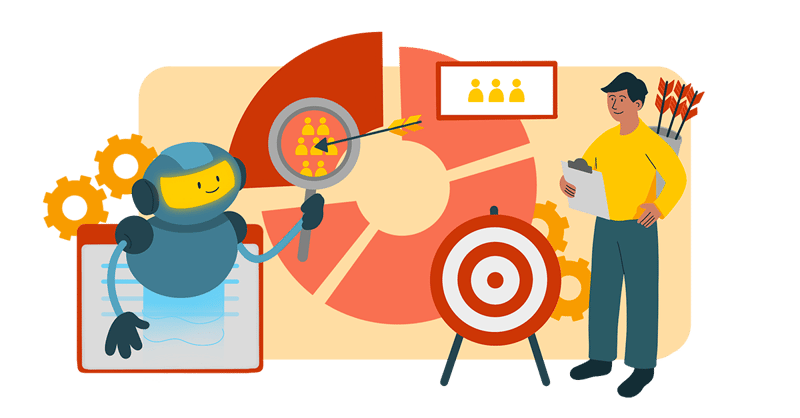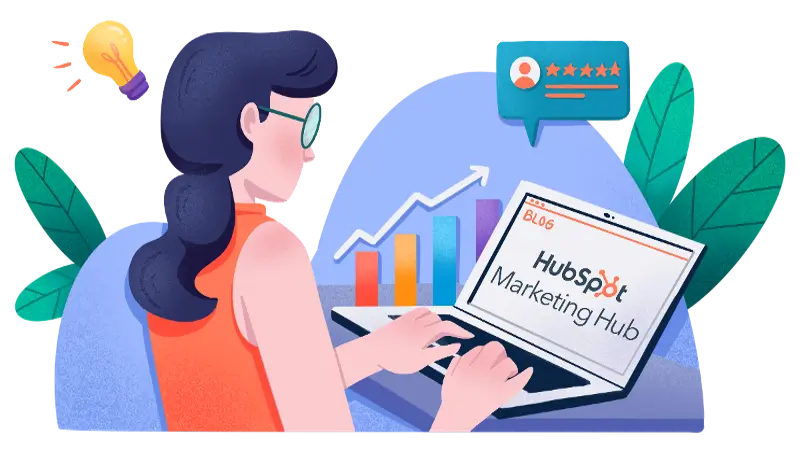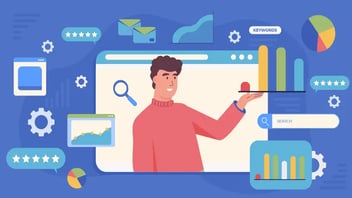Unlock SEO success: Learn how we use HubSpot Content Hub for SEO, boost rankings, increase organic traffic, and optimize our content for success.
Customer Segmentation with AI: Targeting the Right Audience
Are you looking to enhance your customer segmentation with AI?
Welcome to the era of precision targeting! In the fast-paced marketing world, hitting the bullseye with your audience is the name of the game. But how do you ensure your message reaches the right people in a sea of digital noise? Enter artificial intelligence (AI) and its profound impact on customer segmentation and targeting the right audience for your business.

Gone are the days of relying solely on traditional approaches to identify and engage your target market. AI has stepped onto the marketing stage, armed with algorithms that can unlock valuable insights from vast amounts of data. It's like having a marketing genius plugged into your strategy, making sense of complex customer behaviors, preferences, and trends.
Why Does AI Customer Segmentation Matter?
-
AI can segment customers 100x faster than humans. Gone are the days of laborious and time-consuming customer segmentation. Now, businesses can leverage the power of AI to identify effortlessly and group customers based on their interests, needs, and behaviors. This allows for more effective targeting of marketing campaigns, resulting in increased customer engagement and sales.
-
AI can predict customer churn with 90% accuracy. With AI, businesses can identify customers who may stop using their services and take proactive measures to retain them. This approach is cost-effective in the long run, as retaining existing customers is more economical than acquiring new ones.
-
AI can personalize marketing campaigns with 80% accuracy. AI allows businesses to tailor their marketing messages to their customers, increasing their appeal and potential to drive sales and boost customer satisfaction.
-
AI can increase customer lifetime value by 25%. Implementing AI can boost customer retention and enhance business profitability by enabling them to identify and target their most valuable customers with the most pertinent marketing messages.
-
AI can reduce marketing costs by 30%. Businesses can optimize their marketing spend, allowing them to allocate resources to other key areas of their operations. This is due to AI's ability to increase efficiency in marketing efforts, saving businesses time and money.
Overall, AI-powered customer segmentation is a powerful tool that can help businesses to improve their marketing campaigns and achieve their business goals.
We'll explore the fascinating impact of AI on customer segmentation and reveal strategies to help you hit the bullseye. So fasten your seatbelts and get ready to unlock the power of AI because when it comes to reaching your audience, it's all about targeting!
Understanding Customer Segmentation and Targeting
In the world of marketing, one size does not fit all. Each customer is unique, with different needs, preferences, and behaviors. This is where customer segmentation comes into play. Customer segmentation divides a broader target market into customer groups based on shared characteristics, such as demographics, psychographics, behaviors, and preferences. These unique customer groups, or segments, share common traits that allow marketers to understand them better and design targeted marketing initiatives.
The significance of customer segmentation cannot be overstated. Marketers can craft tailored campaigns that resonate with specific audiences by dividing a larger target market into manageable segments. This approach leads to more efficient resource allocation, as marketers can allocate their time, budget, and efforts where they will yield the highest returns. Ultimately, customer segmentation enables marketers to tailor their strategies, messages, and offerings to specific segments, maximizing their impact and resonance.
Traditional Approaches to Customer Segmentation
Traditionally, customer segmentation relied on demographic factors such as age, gender, income, and location. While these demographic variables still hold value, marketers realized the need to go beyond surface-level characteristics to understand customer behavior and motivations truly.
Psychographic segmentation emerged as a valuable approach, focusing on customers' lifestyles, values, beliefs, and attitudes. By diving deeper into customers' psychological makeup, marketers gained a more nuanced understanding of their target audience, allowing for more effective messaging and product positioning.
But, despite their usefulness, traditional segmentation methods have their limitations. They often rely on static, pre-defined criteria and may overlook evolving customer behaviors and preferences. Additionally, manual segmentation processes can be time-consuming and may not leverage the full potential of available data.
Improving Customer Segmentation with AI
This is where the power of AI steps in. Artificial intelligence algorithms can process massive amounts of data and identify patterns, correlations, and trends that human analysts may miss. AI-powered customer segmentation enables marketers to delve deeper into customer data, uncover hidden insights, and refine their targeting strategies.
AI-powered solutions revolutionize the customer segmentation landscape. With its advanced algorithms and machine learning capabilities, marketers can comprehensively understand their audience beyond demographics and psychographics. By analyzing vast amounts of data, AI can identify complex patterns and behaviors, enabling marketers to make data-driven decisions and personalize their marketing efforts on a granular level.
AI also brings scalability and efficiency to customer segmentation. Instead of manual data analysis, AI automates the process, saving time and resources. Real-time data analysis allows adaptive targeting, ensuring marketers respond promptly to changing customer dynamics.
Now, let's take a more in-depth look at the impact of AI on customer segmentation.
The Rise of AI
Artificial intelligence (AI) has recently emerged as a game-changer in customer segmentation. AI-powered tools and algorithms have revolutionized how businesses understand and target their audiences. Let's delve into the benefits of AI in customer segmentation and explore how it is reshaping the marketing landscape.
-
Enhanced accuracy and precision: AI algorithms can process massive volumes of data in real time, enabling marketers to identify precise customer segments accurately. By incorporating multiple data points and complex variables, AI offers a deeper understanding of customer behaviors and preferences, leading to more effective targeting and messaging.
-
Scalability and efficiency: Traditional customer segmentation methods involve manual analysis and limited sample sizes. AI-powered solutions automate the process, allowing businesses to efficiently scale their segmentation efforts and analyze vast datasets. This scalability ensures marketers can adapt to dynamic market conditions and respond in real-time.
-
Real-time data analysis and adaptive targeting: AI enables marketers to analyze customer data in real-time, keeping up with rapidly changing consumer behaviors and preferences. This allows for adaptive targeting, where marketing messages and offers can be tailored dynamically based on the latest customer insights. Marketers can deliver the right message to the right audience at the right time, increasing the effectiveness of their campaigns.
-
Personalization and improved customer experiences: AI-powered customer segmentation enables marketers to create personalized customer experiences. By understanding individual preferences, behaviors, and purchase history, businesses can deliver targeted messages, recommendations, and offers that resonate with each customer. This level of personalization fosters customer loyalty, increases engagement, and drives higher conversion rates.
The impact of AI on marketing is profound. It empowers businesses to make data-driven decisions, uncover hidden customer trends, and optimize marketing efforts for maximum impact. AI not only streamlines the process of customer segmentation but also enables marketers to personalize their messaging, predict customer behavior, and deliver exceptional customer experiences.
AI-powered customer segmentation is essential to successful marketing strategies as the marketing landscape evolves. By harnessing the capabilities of AI, businesses can gain a competitive edge, better understand their customers, and deliver highly targeted, personalized experiences.
One notable AI tool making waves in the industry is HubSpot's AI tool. By leveraging machine learning algorithms, HubSpot's AI tool provides marketers with powerful segmentation capabilities. It enables businesses to uncover valuable customer insights, refine their target audience, and optimize their marketing efforts for maximum impact.
HubSpot and AI
HubSpot has established itself as a trusted name in the marketing industry, offering a comprehensive suite of tools and solutions to help businesses attract, engage, and delight customers. With a focus on inbound marketing, HubSpot provides software products that enable businesses to streamline their marketing efforts and drive growth.
When it comes to AI-powered customer segmentation, one tool stands out among the rest: HubSpot's AI tool. As a leading marketing software provider, HubSpot has developed a powerful solution that empowers businesses to unlock the full potential of AI in targeting their audience. Let's look closely at HubSpot's AI tool and explore its capabilities.
HubSpot's AI tool takes customer segmentation to the next level by leveraging machine learning algorithms to analyze vast amounts of data and extract meaningful insights. This powerful tool allows marketers to delve deeper into customer behaviors, preferences, and patterns, enabling them to make data-driven decisions and craft highly targeted marketing strategies.
HubSpot's AI tool harnesses the power of machine learning algorithms to identify patterns, correlations, and trends within complex datasets. The AI tool uncovers valuable insights that inform segmentation strategies by analyzing historical data, customer interactions, and other relevant variables.
It also offers a range of features and functionalities designed to enhance customer segmentation efforts, including:
-
Automated segmentation: The AI tool automates the segmentation process, eliminating the need for manual analysis and saving valuable time and resources. Marketers can quickly identify relevant segments based on key criteria and behaviors.
-
Behavioral analysis: The AI tool analyzes customer behaviors across various touchpoints, including website visits, email interactions, social media engagements, and more. This comprehensive analysis provides a holistic view of each customer's preferences and helps identify the most effective targeting strategies.
-
Predictive modeling: Leveraging AI capabilities, the tool can generate predictive models that anticipate future customer behaviors and preferences. This allows marketers to tailor their messaging and offers proactively, staying one step ahead in meeting customer needs.
-
Dynamic audience segmentation: HubSpot's AI tool enables dynamic audience segmentation, allowing marketers to adapt their targeting strategies in real-time. As customer behaviors and preferences evolve, the tool helps identify shifting trends, ensuring marketing efforts remain relevant and effective.
You might also like:
Use Cases of HubSpot's AI Tool
From personal development and lead scoring to content personalization and predictive analytics, HubSpot's AO, with its CRM Integration, offers a comprehensive suite of features to propel businesses toward success. These real-world applications demonstrate the tool's versatility and ability to drive personalized marketing, improve customer experiences, and boost overall campaign performance.
-
Customer Persona Development: HubSpot's AI tool can analyze customer data and behaviors to help businesses develop detailed customer personas. By understanding customer demographics, preferences, motivations, and pain points, companies can create targeted marketing campaigns tailored to specific segments.
-
Lead Scoring Qualification: The AI tool can assess lead quality and assign scores based on various factors, such as engagement level, behavior patterns, and demographic information. This enables businesses to prioritize and focus their efforts on leads most likely to convert, increasing overall efficiency and effectiveness in lead nurturing.
-
Content Personalization: With the help of AI, HubSpot's tool can analyze customer data to deliver personalized content recommendations and experiences. By understanding each individual's preferences and past interactions, businesses can serve relevant content that resonates with their audience, driving engagement and conversions.
-
Email Marketing Optimization: HubSpot's AI tool can optimize email marketing campaigns by analyzing customer engagement data and providing insights on the best time to send emails, subject line optimization, and content personalization. This helps businesses maximize open rates, click-through rates, and overall email campaign performance.
A survey from Mailchimp found that segmented campaigns had open rates 14.31% higher than non-segmented campaigns.
-
Dynamic Website Personalization: Leveraging AI capabilities, HubSpot's tool can dynamically personalize website content based on individual visitor preferences and behavior. Businesses can enhance the user experience, increase engagement, and drive conversions by serving tailored content, recommendations, and offers.
-
Predictive Analytics for Upselling and Cross-Selling: The AI tool can analyze customer purchase history, browsing behavior, and other data points to identify opportunities for upselling and cross-selling. Businesses can proactively offer relevant products or services by predicting customer needs and preferences, increasing revenue and customer satisfaction.
-
Social Media Targeting: HubSpot's AI tool can analyze social media data and engagement patterns to identify the most relevant channels, content types, and messaging for specific customer segments. This allows businesses to effectively optimize their social media marketing efforts and connect with their target audience.
-
Campaign Performance Analysis: The AI tool provides an in-depth analysis of marketing campaign performance, highlighting key metrics and insights. It can identify patterns, trends, and correlations within campaign data, helping marketers optimize their strategies and make data-driven decisions to improve future campaign performance.
Research from HubSpot shows that segmentation helped businesses create websites that are 2-5x more effective than those that provide the same content for all users.
These use cases highlight the versatility of HubSpot's AI tool in various aspects of marketing, enabling businesses to leverage AI-driven insights and automation for more effective customer segmentation, personalized marketing, and overall campaign optimization.
Best Practices for AI-Driven Customer Segmentation
AI-driven customer segmentation has the potential to revolutionize your marketing efforts, but it's essential to approach it strategically and with best practices in mind. Here are some fundamental guidelines to follow when implementing AI-driven customer segmentation:
-
Set Clear Objectives: Clearly define your segmentation goals and what you aim to achieve through AI-driven customer segmentation. Whether it's improving targeting precision, increasing conversion rates, or enhancing customer satisfaction, having clear objectives will guide your segmentation strategy and ensure alignment with your overall business goals.
-
Collect Relevant and Quality Data: The success of AI-driven customer segmentation relies on the quality and relevance of the data you collect. Ensure to gather various data points, including demographic, behavioral, and psychographic information. To comprehensively view your audience, utilize multiple data sources, such as CRM data, website analytics, social media insights, and customer surveys.
-
Leverage Machine Learning Algorithms: AI tools like HubSpot's AI tool leverage machine learning algorithms to identify patterns and insights in your data. Take advantage of these capabilities by allowing the algorithms to analyze your data and generate meaningful segments. Regularly monitor and fine-tune the algorithms to ensure accuracy and relevance as customer behaviors and preferences evolve.
-
Validate Segments with Customer Feedback: While AI algorithms can provide valuable insights, validating your segments with direct customer feedback is essential. Conduct surveys, interviews, or focus groups to gather input from your target audience. This feedback will help refine your segments and ensure they align with customer perceptions and expectations.
-
Test and Iterate: Implementing AI-driven customer segmentation is an ongoing process. Continuously test and iterate your segmentation strategies to improve accuracy and effectiveness. Experiment with different variables, segment definitions, and messaging approaches to find the optimal combination that resonates with your audience.
-
Integrate Segmentation: Once you have defined your segments, integrate them into your marketing campaigns and strategies. Develop targeted messaging, personalized content, and tailored offers for each segment. Monitor campaign performance closely and make data-driven adjustments to optimize your efforts.
-
Ensure Data Privacy and Compliance: With the collection and use of customer data, it's crucial to prioritize data privacy and comply with relevant regulations, such as GDPR or CCPA. Implement robust data security measures, such as using a strong VPN and two-factor authentication methods, obtaining necessary consent, and providing transparency to customers regarding data usage and segmentation practices.
By following these best practices, you can maximize the benefits of AI-driven customer segmentation, deliver personalized experiences to your target audience, and drive meaningful results in your marketing efforts. Remember, the key is to align AI capabilities with your business objectives and continuously adapt your strategies based on customer feedback and evolving market dynamics.
Unleashing the Potential: AI-Driven Customer Segmentation for Marketing Success
In conclusion, customer segmentation is a fundamental concept in marketing that allows businesses to reach their target audience effectively. While traditional approaches have their merits, AI-powered solutions like HubSpot's AI tool have reshaped customer segmentation by offering greater accuracy, scalability, and efficiency.
The use case of customer segmentation with AI in business is immense, and by embracing AI and including it in your Sales training and processes, marketers and sales executives can unlock valuable insights, better understand their customers, and deliver personalized experiences that resonate with their target audience.
Customer Segmentation FAQs
Customer segmentation is the process of dividing customers into groups based on their shared characteristics, such as demographics, interests, or behavior. This allows businesses to target their marketing messages more effectively and efficiently.
Customer segmentation is one of the best ways to reach different sections of your customers at the right time and with the best information.
AI can help with customer segmentation in a number of ways.
- First, AI can help businesses to collect and analyze large amounts of customer data more quickly and easily. This allows businesses to identify hidden patterns and insights that would be difficult to find using traditional methods.
- Second, AI can help businesses to automate the customer segmentation process. This frees up human resources to focus on other tasks, such as developing marketing campaigns.
- Third, AI can help businesses to personalize their marketing messages. This can lead to increased customer engagement and sales.
The benefits of using AI for customer segmentation include:
- Increased accuracy: AI can help businesses to segment customers more accurately than traditional methods. This is because AI can identify hidden patterns and insights that would be difficult to find using traditional methods.
- Increased efficiency: AI can help businesses to automate the customer segmentation process. This frees up human resources to focus on other tasks, such as developing marketing campaigns.
- Increased personalization: AI can help businesses to personalize their marketing messages. This can lead to increased customer engagement and sales.
The challenges of using AI for customer segmentation include the following:
- Data quality: Customer data quality is essential for accurate customer segmentation. If the data is not accurate, the segmentation results will be inaccurate.
- Technical expertise: AI can be a complex technology to implement. Businesses need to have the technical expertise to implement and use AI effectively.
- Cost: AI can be a costly technology to implement. Businesses must be prepared to invest in AI to reap the benefits.
Some examples of how AI is being used for customer segmentation include:
- Netflix uses AI to recommend movies and TV shows to its users.
- Amazon uses AI to recommend products to its customers.
- Spotify uses AI to create personalized playlists for its users.
- Retail businesses use AI to track customer behavior and identify potential customers.
Predictive audience segmentation is a technique where AI and data analytics are used to anticipate the preferences and behaviors of different audience segments. It anticipates future actions or tendencies.
This content is also available in:
- German: Kundensegmentierung mit KI: Die richtige Zielgruppe ansprechen
- Spanish: Segmentación de clientes con IA: Dirigirse al Público Adecuado
- French: Segmentation client grâce à l'IA : Cibler la bonne audience
- Italian: Segmentazione dei clienti con l'iIA: targettizzare il pubblico giusto
- Romanian: Segmentarea cu ajutorul IA: direcționarea către publicul potrivit
- Chinese: 利用人工智能进行客户细分:瞄准正确的受众











Leave a Comment